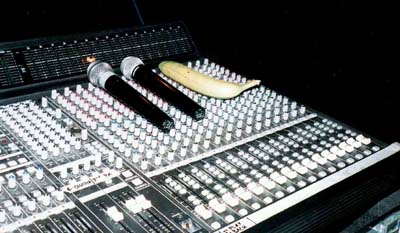How to Live Well While Monitoring Live

Image borrowed from Roadie.net
"What is the best monitor mix for a live performance?"
I've been mulling that question for a while. While looking at it from the perspective of a musician, a monitor engineer, and a front-of-house mixer, I've reached some conclusions. First off, I've decided what it isn't: It isn't a mix which sounds like a CD on the stereo at home. It isn't necessarily very pretty. It isn't necessarily in propoprtion. And it isn't very complex.
Well, then, what the heck is it?
Well, it's a tool to help you make good music, created within the confines of also avoiding feedback and controlling the quality and loudness of the mix being sent to the front-of-house. Ooooo... Technical. What does that mean? The idea is to give you the things in your monitor which you need to perform, while keeping the stage level low enough to neither blow everyone off the stage nor fight with the main house mix. Ahhh... That makes more sense!
So, how do we keep the level down? By keeping the monitor mixes as spare and quiet as possible. Don't put anything in you don't absolutely need to hear to play, and don't jack things up too far. Remember also that much of what you might want to put in the mix is already spilling onto the stage. If there is an instrument you need to play off and you can't get it from the stage spill, put it in. If you need to harmonize with other vocalists, put them in. But remember, as the mixes become more and more complex and the levels go up, intelligibility, the ability to discern any particular component of the mix, goes down. If you can't hear an item, don't just crank up that item. First try removing whatever is in the way. This is truly a case of less is more.
In fact, having mxed monitors for some fairly big acts, I can say that you might be more impressed to find out what isn't in their monitors than what is.
For an example, look HERE.